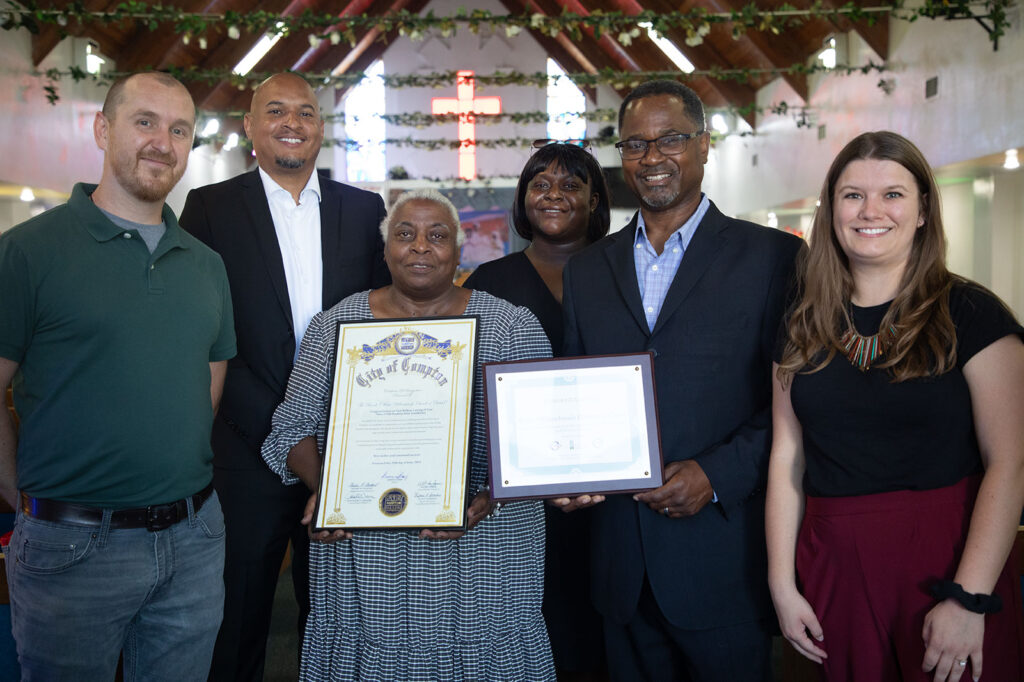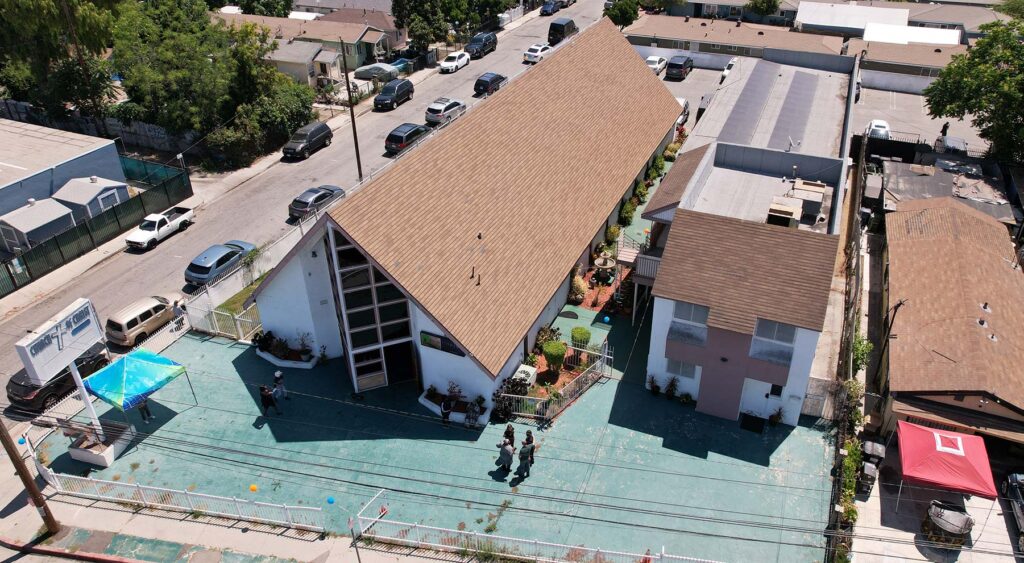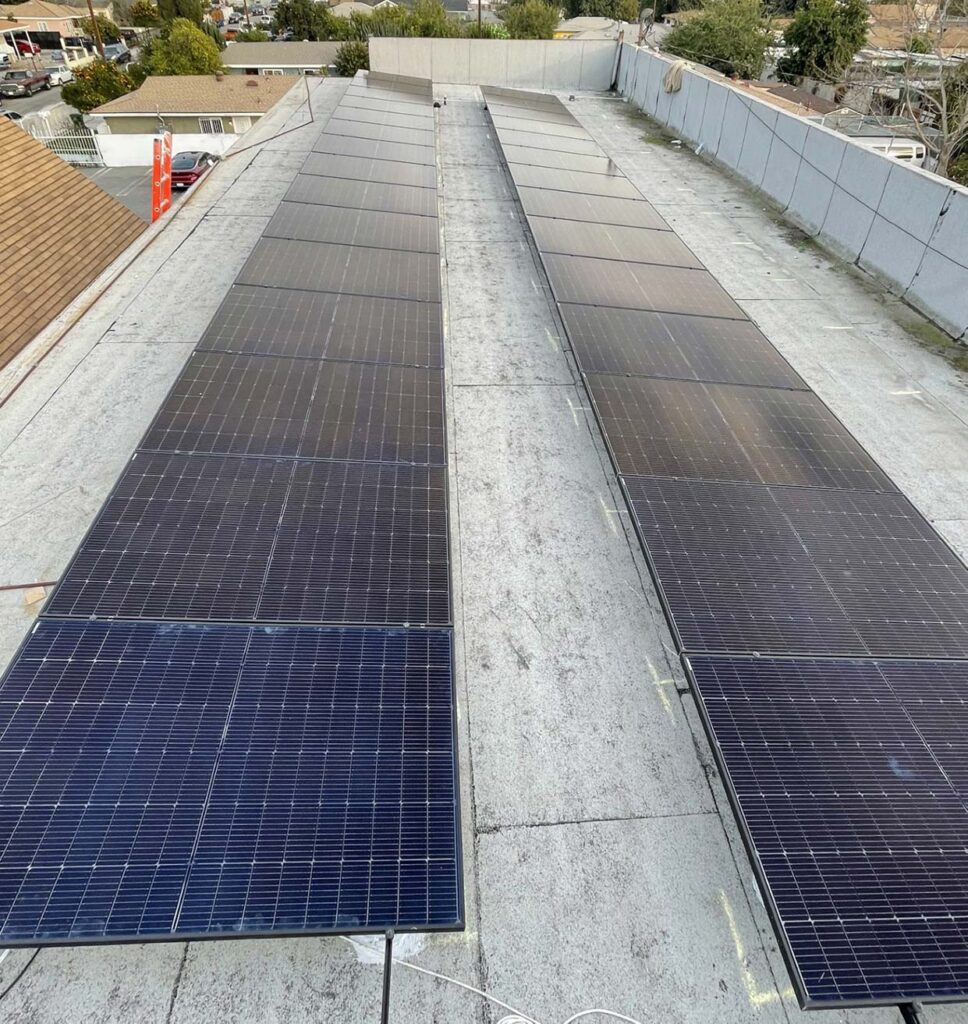
Financing Solar Panels Just Became Much Easier. Thank the Climate Bill.
Thanks to the Inflation Reduction Act, a new financing model can make solar easier to access for low-income households and nonprofits. Here’s how a church in Compton put it to work.
For a more detailed look at this finance model and how you can set up this type of program, see our memo: Scaling Low-Income Solar with the Inflation Reduction Act.
Running in two straight lines across the roof and already providing power to the building below, the twenty-nine brand-new solar panels gleam in the sun on the day of the community ribbon cutting.
A crowd has gathered at the Watts-Willowbrook Church of Christ — known as The Brook — in Compton, California, including the city mayor, local elected officials, and congregation members, to celebrate the commissioning of the solar array. “The Watts-Willowbrook Church of Christ going solar is a ray of hope,” Jacquelyn Badejo, Chair of the Climate Emergency Mobilization Office for the City of Los Angeles, says. Jacquelyn (who also goes by Jackie) and her mother, Ms. Linda Cleveland, are long-time members of the congregation and led The Brook’s efforts to go solar.

From left to right: Andreas Karelas, RE-volv, Executive Director, Mario Holten, Wells Fargo Foundation, Vice President of Philanthropy and Community Impact, Ms. Linda Cleveland, Church Secretary and long-time environmental activist, Jacquelyn Badejo, Chair of the Climate Emergency Mobilization Office, City of Los Angeles, Pastor Ernest Garrett, Bekah Estrada, California Interfaith Power & Light, Southern California Director. Photo credit: RE-volv
The 12kW project, which will reduce climate pollution equivalent to what’s sequestered by 350 acres of trees every year, will soon be complemented by a battery storage system that will allow the church to function as a resiliency hub. The church has hopes to provide emergency services, such as running the air conditioning during heatwaves. In addition to serving the South-Central Los Angeles community, The Brook will save more than $180,000 on electricity costs in the next twenty years, and — thanks to an innovative financing model made more accessible by the Inflation Reduction Act — they didn’t have to pay any upfront costs for the system.
Historically, households or organizations that wanted to go solar either had to own the system outright, which for low-income households often meant an unfeasible upfront cost and the inability to take advantage of federal tax incentives; or go through a third-party lease or power purchase agreement (PPA), with less attractive long-term financial returns.
Now, game-changing incentives exist, unlocking solar for low-income households and nonprofit organizations.
An innovative new way to finance solar projects
The Inflation Reduction Act (IRA) offers a new incentive that allows tax-exempt entities, such as cities or nonprofits, to receive 30 percent — and potentially up to 70 percent — cash back on the cost of the down payment of a clean energy project. Known as Direct Pay, or elective pay, this provision is revolutionary because tax-exempt entities who were once not eligible for these tax credits can now take advantage. There are already examples of cities using Direct Pay for their own projects, such as San Antonio, Texas and McFarland, Wisconsin.
But these tax credits can also be used when non-taxable financial entities, such as green banks, Community Development Financial Institutions (CDFIs), or nonprofit organizations, are the third-party owner of a clean energy project — like rooftop solar — where another organization or household is the recipient. Through this model, the third party owns the system and pays the upfront costs, which means the solar recipient, such as The Brook church, pays only a monthly payment. Because the owner — in the case of The Brook, a nonprofit called RE-volv that’s been financing nonprofit solar projects since 2011— can negotiate bulk rates and take advantage of tax credits, the recipient’s monthly lease payment is lower than previous electricity costs, allowing them to save money over the course of the panels’ lifetime.
This third-party financial model pays it forward by the owner investing any payback received above the project cost into other solar projects, further accelerating solar adoption and accessibility. After at least five years, the solar recipients have the option to buy the system.

Photo credit: RE-volv
The economics could not be better for nonprofits and low-income households to go solar
Programs under this model are typically led by nonprofits, which are community-focused and not driven by profit. These nonprofits are more likely to pursue low-cost capital, such as low-interest loans, to cover the portion of the system cost not covered by tax credits. As a result, the lower costs are passed down to customers. A household’s monthly payment under this model can therefore be lower than a commercial PPA or lease payment.
This means larger savings over time. In Nevada, for example, a household might save $10,000 over twenty years through a traditional solar loan. But with this new model, they could save $12,600–$17,800 — and that’s a conservative estimate, according to RMI’s Green Upgrade Calculator; those savings could actually be $16,300–$20,400. An extra thousand dollars a year is breathing room for families who are experiencing higher costs of living than ever, and it could make a real difference in people’s lives.

Photo credit: RE-volv
In addition to Direct Pay, there are other IRA programs making this model even more financially feasible. The Greenhouse Gas Reduction Fund (GGRF) provides $27 billion in funding that could be used to scale this model by providing a combination of upfront capital, low-interest loans, and other support such as risk mitigation tools, that can further accelerate solar adoption.
While there are early adopters setting a path for others to follow, this model is still new. RMI’s RISE Cohort aims to accelerate the awareness and adoption of this model by working directly with local governments and tax-exempt financial institutions who are forming partnerships to create these programs. The RISE cohort provides technical assistance, case studies, and insights from legal experts to set these organizations up to create these programs. Local governments engage the community to increase awareness and participation in these programs, while the financial institutions select developers, negotiate bulk rates, and enable local solar developers to install solar and/or storage systems. For a more detailed look at this solar finance model and RMI’s RISE cohort program, see our memo: Scaling Low-Income Solar with the Inflation Reduction Act.
The ripple effect of solar
For many organizations and households, rooftop solar — and the myriad benefits that come with it, such as lower electricity bills, cleaner air, and increased resilience — have been out of reach. Not anymore. This new model opens up doors that could become a tidal wave of solar. The Brook’s commitment to solar and resiliency is having a ripple impact in the community and nationally. Since The Brook’s solar ribbon cutting, five other congregations in Compton have expressed interest. Representatives from The Brook were also recently invited to a White House convening to share their story with over 50 selected faith leaders from across the United States.
That is the true benefit of the IRA — that in as much as it provides funding for individual projects, it also spurs private investment and seeds inspiration for others to follow in the footsteps of those who go first. The sun is plentiful, and the opportunity is there — it’s time to reach out and take it.
Header image photo credit: RE-volv